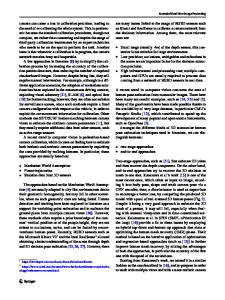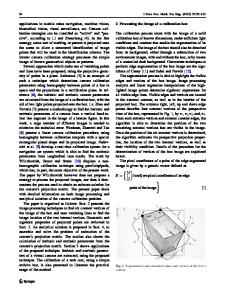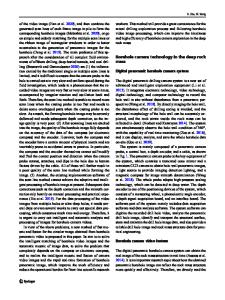High Precision Camera Calibration
A calibrated camera is the key to each optical measurement problem. This work introduces camera modelling and calibration in computer vision. Tobias Hanning explains the classic pinhole camera model with distortion derived from third order optics and show
- PDF / 2,999,434 Bytes
- 225 Pages / 419.528 x 595.276 pts Page_size
- 27 Downloads / 485 Views
VIEWEG+TEUBNER RESEARCH
Tobias Hanning
High Precision Camera Calibration
VIEWEG+TEUBNER RESEARCH
Bibliographic information published by the Deutsche Nationalbibliothek The Deutsche Nationalbibliothek lists this publication in the Deutsche Nationalbibliografie; detailed bibliographic data are available in the Internet at http://dnb.d-nb.de.
Habilitation thesis University of Passau, 2009
1st Edition 2011 All rights reserved © Vieweg+Teubner Verlag | Springer Fachmedien Wiesbaden GmbH 2011 Editorial Office: Ute Wrasmann | Sabine Schöller Vieweg+Teubner Verlag is a brand of Springer Fachmedien. Springer Fachmedien is part of Springer Science+Business Media. www.viewegteubner.de No part of this publication may be reproduced, stored in a retrieval system or transmitted, in any form or by any means, electronic, mechanical, photocopying, recording, or otherwise, without the prior written permission of the copyright holder. Registered and/or industrial names, trade names, trade descriptions etc. cited in this publication are part of the law for trade-mark protection and may not be used free in any form or by any means even if this is not specifically marked. Cover design: KünkelLopka Medienentwicklung, Heidelberg Printing company: STRAUSS GMBH, Mörlenbach Printed on acid-free paper Printed in Germany ISBN 978-3-8348-1413-5
Contents List of symbols . . . . . . . . . . . . . . . . . . . . . . . . . . . . . .
xi
1
Introduction 1.1 Motivation . . . . . . . . . . . . . . . . . . . . . . . . . . . . . . 1.2 Outline . . . . . . . . . . . . . . . . . . . . . . . . . . . . . . . 1.3 Contribution . . . . . . . . . . . . . . . . . . . . . . . . . . . . .
1 1 2 4
2
Modelling the camera mapping 2.1 Geometric optics for computer vision . . . . . . . . . . 2.1.1 The “thin lens” assumption and first order optics 2.1.2 The circle of confusion . . . . . . . . . . . . . . 2.1.3 Image acquisition . . . . . . . . . . . . . . . . . 2.1.3.1 The sensor array . . . . . . . . . . . . 2.1.3.2 A simplified sensor model . . . . . . . 2.1.3.3 The sensor array as coordinate system 2.2 The pinhole camera model . . . . . . . . . . . . . . . . 2.3 Third order optics and thick lenses . . . . . . . . . . . . 2.4 The pinhole camera model with distortion . . . . . . . . 2.4.1 Definition . . . . . . . . . . . . . . . . . . . . . 2.4.2 Radial distortion . . . . . . . . . . . . . . . . . 2.4.3 Radius transformations . . . . . . . . . . . . . . 2.4.4 Other distortion functions . . . . . . . . . . . . 2.4.4.1 Misaligned thin lens . . . . . . . . . . 2.4.4.2 Misaligned lens systems . . . . . . . . 2.5 Inverting the camera mapping . . . . . . . . . . . . . . 2.6 The pinhole camera model in homogeneous coordinates .
v
. . . . . . . . . . . . . . . . . .
. . . . . . . . . . . . . . . . . .
. . . . . . . . . . . . . . . . . .
. . . . . . . . . . . . . . . . . .
. . . . . . . . . . . . . . . . . .
5 5 5 8 9 9 11 12 13 15 17 17 18 19 21 21 22 23 25
3
4
Error functions for camera calibration and 3D reconstruction 3.1 Introduction . . . . . . . . . .
Data Loading...











